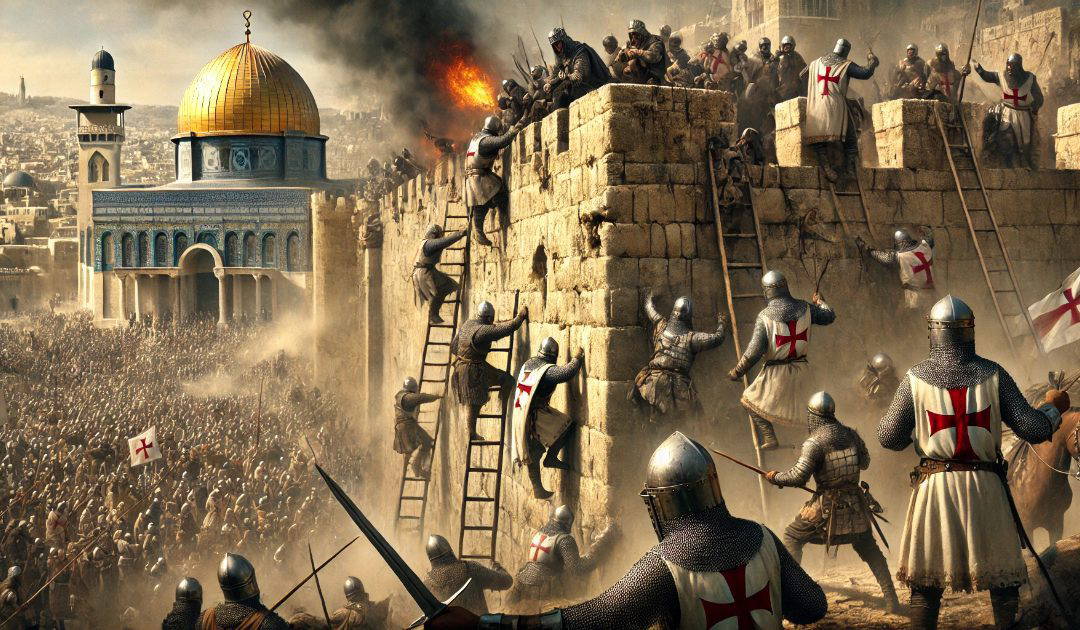On the 7th of June, 1099, during the First Crusade, the Siege of Jerusalem began. This siege not only symbolised the efforts of the crusaders to reclaim the Holy Land from Muslim rule but also embodied the religious fervour and military prowess of the time.
The roots of the siege can be traced back to Pope Urban II’s call in 1095, urging Western Christians to aid their Eastern counterparts and reclaim Jerusalem from Islamic control. Thousands from across Europe heeded the call, motivated by religious zeal, prospects of glory, or promises of land and wealth. The journey to Jerusalem was arduous, with the crusaders enduring hardships, starvation, and numerous battles en route.
By the summer of 1099, the crusaders had finally reached the outskirts of Jerusalem. The city, held by Fatimid Muslims, was a fortress in its own right, surrounded by strong walls and defended by determined soldiers. The besieging crusaders, numbering around 1,200 knights and 12,000 foot soldiers, faced daunting odds. Yet, their resolve was strengthened by religious conviction that God’s will was on their side.
The crusaders, lacking in supplies and manpower, were initially at a disadvantage. They had to overcome the formidable city walls and deal with the scarcity of food and water. Early attempts to breach the city’s defences were thwarted, and the heat of the summer took its toll.
The turning point came when a Genoese fleet arrived at Jaffa, providing the crusaders with essential supplies and materials to construct siege engines. Under the direction of key leaders like Godfrey of Bouillon, the crusaders built siege towers and ladders, redoubling their efforts to storm the city.
On the 14th of July, 1099, the crusaders launched their final assault. After a night of fervent prayer and fasting, they advanced their siege towers towards the city walls. The decisive moment came when Godfrey’s tower reached the northern wall, and his men were able to breach the fortifications. Once inside, the crusaders opened the gates for their comrades, and a brutal, chaotic storming ensued.
The capture of the city was marked by horrific slaughter. Reports from the time, like those chronicled by the anonymous author of the “Gesta Francorum,” describe the streets of Jerusalem running red with blood as the crusaders killed Muslim soldiers and civilians alike. The violence extended to Jews who had taken refuge in their synagogues.
Once the dust settled, the crusaders gathered at the Church of the Holy Sepulchre to give thanks. Jerusalem became part of the newly established Latin Kingdom of Jerusalem, with Godfrey of Bouillon assuming the title of Advocate of the Holy Sepulchre. This victory was seen as a divine endorsement of the crusaders’ cause and served to strengthen the Christian hold on the Holy Land for decades.
The siege and its aftermath had profound implications. On one hand, the successful capture of Jerusalem galvanised further crusading efforts, leading to subsequent Crusades. On the other hand, it left a legacy of animosity and resentment between Christians and Muslims, contributing to centuries of conflict.
In the broader historical context, the Siege of Jerusalem in 1099 is often viewed as a pivotal moment in Medieval history. It exemplified the deep intertwining of faith and warfare during the period and highlighted the lengths to which individuals would go for religious ideals. Moreover, it underscored the complexities of interactions between different cultures and religions, laying the groundwork for future engagements and conflicts.

